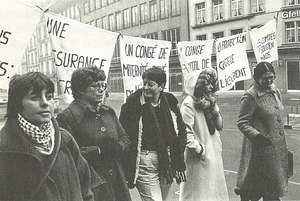
Unternavigation
Ruth Dreifuss
Social democrat Ruth Dreifuss was the second woman to be elected to the Federal Council. From her election in 1993 to the end of her tenure in 2002, she headed the Federal Department of Home Affairs. Her most important achievements included the introduction of the Federal Act on Health Insurance (1994-1996), the tenth AHV revision (1997) and the preparations for its eleventh revision. She was also committed to introducing maternity leave.

Ruth Dreifuss was born in St. Gallen on 9th January 1940. After her family moved to Geneva, she completed her school education there and gained a diploma in business management. Due in part to financial reasons as well as traditional gender roles, her parents discouraged young Ruth Dreifuss from continuing her studies at university. Following her education at the Geneva School of Social Studies, she became a social worker and developed an acute awareness of issues related to poverty and marginalisation.
In 1965, at the age of 25, she joined the Social Democratic Party and was one of the co-founders of the left-wing magazine Domaine public. Her growing interest in economic and social analysis inspired her to attend evening classes and study at the University of Geneva. After obtaining a degree in economics, she worked as a scientific collaborator in the development cooperation and humanitarian aid branch of the Federal Department of Foreign Affairs. She held this position from 1972 to 1981.
At the end of the 1960s, she campaigned against the Vietnam War, was involved in the 1968 social movement and became interested in issues concerning third-world countries. Though she initially demonstrated little interest for feminism, she did express her gratitude to the feminist movement of the 1970s. The movement's criticism of women's underrepresentation in trade union bodies resulted in the Swiss Federation of Trade Unions (SGB) electing her as the first female member of its national direction in 1981. In this role, she was responsible for labour law, social insurance and women’s affairs. At the beginning of the 1980s, she was also responsible for the SGB campaign in support of maternity insurance. Despite her efforts, the initiative was clearly defeated at the ballot in 1984. Ruth Dreifuss headed the SGB until she was elected to the Federal Council.
In 1993, the non-election of the official SP candidate, Christiane Brunner from Geneva prompted women to turn out in protest on the Bundesplatz in Bern. In part, it was this broad feminist protest that then led to Ruth Dreifuss’ election. She was the second woman (after FDP liberal Elisabeth Kopp) and the first female social democrat elected to the Federal Council – and later the first female Federal President of Switzerland in 1999.
In her role as head of the Department of Home Affairs, Ruth Dreifuss oversaw several revisions of social insurance laws. Between 1994 and 1996 she worked on the Federal Act on Health Insurance (KVG), for which she was heavily criticised, especially due to the steadily rising premiums and healthcare costs. She implemented the third revision to disability insurance in 1995 and got to work on the fourth revision, which was passed after her tenure in 2004. The tenth AHV revision entered into force in 1997 and put into effect a number of important demands she had raised as a trade unionist: a individual pension system less dependent on civil status, credits for child-raising expenses, improvements to widow’s pensions and pension splitting (the calculation of pensions on the basis of the splitting of household income between both spouses during their marriage). A progressive increase to women’s retirement age was, however, also introduced during her time in office (from 62 to 63 years in 2001 and to 64 years in 2005). Dreifuss likewise prepared the grounds for the parliamentary debate of the eleventh AHV revision, which was unsuccessful; it included a further increase to women’s retirement age. She was also highly committed to introducing maternity leave during her tenure as federal councillor. She had the backing of the committees for maternity insurance, which emerged following the women’s strike of 1991; these committees brought about an unprecedented wave of feminist activism in Switzerland. In 1999, an initial proposal was rejected by 61 percent of voters. It was not until 2004, two years after she had stepped down as federal councillor, that maternity leave was adopted at the federal level. In contrast to the original proposal of 1999, however, paid maternity leave was only provided to employed women. It stipulated a daily allowance of 80 percent of their wage for a period of 14 weeks following birth.
Literatur / Bibliographie / Bibliografia / References: Fischli Isabella Maria, Dreifuss ist unser Name. Eine Politikerin, eine Familie, ein Land, Zürich, 2002; Kuntz Joëlle (Interview von), Ruth Dreifuss. Du social au politique, Plans Fixes (Videoaufnahme), 1125, Bern, 1995, http://www.plansfixes.ch.
(12/2014)



